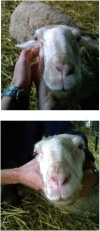Diagnosing limb paresis and paralysis in sheep
- PMID: 26752801
- PMCID: PMC4686802
- DOI: 10.1136/inp.h5547
Diagnosing limb paresis and paralysis in sheep
Abstract
Paresis and paralysis are uncommon problems in sheep but are likely to prompt farmers to seek veterinary advice. A thorough and logical approach can aid in determining the cause of the problem and highlighting the benefit of veterinary involvement. While this may not necessarily alter the prognosis for an individual animal, it can help in formulating preventive measures and avoid the costs - both in economic and in welfare terms - of misdirected treatment. Distinguishing between central and peripheral lesions is most important, as the relative prognoses are markedly different, and this can often be achieved with minimal equipment. This article describes an approach to performing a neurological examination of the ovine trunk and limbs, the ancillary tests available and the common and important causes of paresis and paralysis in sheep.
Figures









Similar articles
-
The management and welfare of some common ovine obstetrical problems in the United Kingdom.Vet J. 2005 Jul;170(1):33-40. doi: 10.1016/j.tvjl.2004.03.010. Vet J. 2005. PMID: 15961334 Review.
-
Clinical practice guideline: Bell's palsy.Otolaryngol Head Neck Surg. 2013 Nov;149(3 Suppl):S1-27. doi: 10.1177/0194599813505967. Otolaryngol Head Neck Surg. 2013. PMID: 24189771
-
The potential for improving welfare standards and productivity in United Kingdom sheep flocks using veterinary flock health plans.Vet J. 2007 May;173(3):522-31. doi: 10.1016/j.tvjl.2006.02.007. Epub 2006 Apr 24. Vet J. 2007. PMID: 16632388
-
The management of peripheral facial nerve palsy: "paresis" versus "paralysis" and sources of ambiguity in study designs.Otol Neurotol. 2010 Feb;31(2):319-27. doi: 10.1097/MAO.0b013e3181cabd90. Otol Neurotol. 2010. PMID: 20009779
-
Protozoan infections (Toxoplasma gondii, Neospora caninum and Sarcocystis spp.) in sheep and goats: recent advances.Vet Res. 1998 May-Aug;29(3-4):289-310. Vet Res. 1998. PMID: 9689743 Review.
Cited by
-
Cervical Vertebral Stenotic Myelopathy in a Nelore Calf.Vet Sci. 2022 Dec 16;9(12):699. doi: 10.3390/vetsci9120699. Vet Sci. 2022. PMID: 36548860 Free PMC article.
-
Three cases of paresis due to vertebral abscess in Shiba goats in Japan.J Vet Med Sci. 2024 Sep 1;86(9):946-950. doi: 10.1292/jvms.24-0158. Epub 2024 Jul 23. J Vet Med Sci. 2024. PMID: 39048345 Free PMC article.
-
Establishment of a Sheep Model for Hind Limb Peripheral Nerve Injury: Common Peroneal Nerve.Int J Mol Sci. 2021 Jan 30;22(3):1401. doi: 10.3390/ijms22031401. Int J Mol Sci. 2021. PMID: 33573310 Free PMC article.
-
Modelling Neurological Diseases in Large Animals: Criteria for Model Selection and Clinical Assessment.Cells. 2022 Aug 25;11(17):2641. doi: 10.3390/cells11172641. Cells. 2022. PMID: 36078049 Free PMC article. Review.
-
CRISPR/Cas9 mediated generation of an ovine model for infantile neuronal ceroid lipofuscinosis (CLN1 disease).Sci Rep. 2019 Jul 9;9(1):9891. doi: 10.1038/s41598-019-45859-9. Sci Rep. 2019. PMID: 31289301 Free PMC article.
References
-
- BENAVIDES J., GARCÍA-PARIENTE C., FERRERAS M. C., FUERTES M., GARCÍA-MARÍN J. F., PEREZ V. (2007) Diagnosis of clinical cases of the nervous form of maedi–visna in 4- and 6-month old lambs. Veterinary Journal 174, 655–658 - PubMed
-
- BENAVIDES J., GÓMEZ N., GELMETTI D., FERRERAS M. C., GARCÍA-PARIENTE C., FUERTES M., OTHERS (2006) Diagnosis of the nervous form of maedi–visna infection with a high frequency in sheep in Castilla y Leon, Spain. Veterinary Record 158, 230–235 - PubMed
-
- CONSTABLE P. D. (2004) Clinical examination of the ruminant nervous system. Veterinary Clinics of North America: Food Animal Practice 20, 185–214 - PubMed
-
- FORMISANO P., ALDRIDGE B., ALONY Y., BEEKHUIS L., DAVIES E., DEL POZO J., DUN K., ENGLISH K., OTHERS (2013) Identification of Sarcocystis capracanis in cerebrospinal fluid from sheep with neurological disease. Veterinary Parasitology 193, 252–255 - PubMed
-
- HEALY A. M., WEAVERS E., MCELROY M., GOMEZ-PARADA M., COLLINS J. D., O'DOHERTY E., SWEENEY T., DOHERTY M. L. (2003) The clinical neurology of scrapie in Irish sheep. Journal of Veterinary Internal Medicine 17, 908–916 - PubMed
Further reading
-
- DE LAHUNTA A., GLASS E., KENT M. (2015) Veterinary Neuroanatomy and Clinical Neurology. 4th edn Saunders Elsevier
-
- MAYHEW J. (2008) Large Animal Neurology. 2nd edn Wiley-Blackwell
-
- PLATT S., OLBY N. (2013) BSAVA Manual of Canine and Feline Neurology, 4th edn British Small Animal Veterinary Association (While admittedly focussed on small animals, the principles of spinal and peripheral nerve disorders and the neurological examination are very well explained in this book, which is probably more easily available to many practitioners than specific large animal neurology textbooks)
-
- SCOTT P. R. (1994) Cerebrospinal fluid analysis in the differential diagnosis of spinal cord lesions in ruminants. In Practice 16, 301–303
LinkOut - more resources
Full Text Sources
Other Literature Sources
